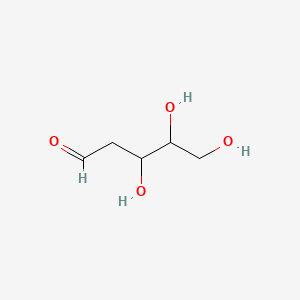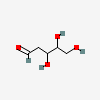3,4,5-Trihydroxypentanal
- 3,4,5-trihydroxypentanal
- 2-Deoxypentose
- Thyminose
- 2-DEOXY-L-RIBOSE
- D-2-Deoxyribose
- Create:2005-03-27
- Modify:2025-01-18
 2-Deoxy-D-ribose (annotation moved to).
2-Deoxy-D-ribose (annotation moved to).

- 2 Deoxyribose
- 2-Deoxyribose
- Deoxyribose
- 3,4,5-trihydroxypentanal
- 2-Deoxypentose
- Thyminose
- 2-DEOXY-L-RIBOSE
- D-2-Deoxyribose
- 2-Deoxyribose
- D-Ribose, 2-deoxy-
- 18546-37-7
- 408526-38-5
- D-erythro-Pentose, 2-deoxy-
- 2-Deoxy-D-xylose
- Ribose, 2-deoxy-
- 2-Deoxy-D-arabinose
- .deoxyribose
- MFCD00135904
- MFCD09880214
- 2-Desoxy ribose
- D-2-Desoxyribose
- Ribose, 2-deoxy-, D-
- SCHEMBL477499
- 2-Deoxypentose-, D-erythro- #
- DTXSID30862138
- ASJSAQIRZKANQN-UHFFFAOYSA-N
- CHEBI:131350
- NSC76307
- NSC-76307
- AS-11980
- SY023057
- SY067421
- DB-021000
- DB-021003
- NS00120213
- EN300-244299
- 2-Deoxy-D-ribose,low endotoxins ≤ 10 EU/mg
- Q27225109
- 06FD3444-8F86-4568-B467-7DE978E83287
- 2-Deoxy-D-arabinose; 2-Deoxy-D-erythropentose; Thyminose;(3S,4R)-3,4,5-trihydroxypentanal
115.002411 100
71.012421 46.40
133.012939 36.66
132.995300 30.22
72.991646 9.82
 2-Deoxy-D-ribose (annotation moved to)
2-Deoxy-D-ribose (annotation moved to)
H315 (100%): Causes skin irritation [Warning Skin corrosion/irritation]
H319 (100%): Causes serious eye irritation [Warning Serious eye damage/eye irritation]
H335 (100%): May cause respiratory irritation [Warning Specific target organ toxicity, single exposure; Respiratory tract irritation]
P261, P264, P264+P265, P271, P280, P302+P352, P304+P340, P305+P351+P338, P319, P321, P332+P317, P337+P317, P362+P364, P403+P233, P405, and P501
(The corresponding statement to each P-code can be found at the GHS Classification page.)
Aggregated GHS information provided per 2 reports by companies from 2 notifications to the ECHA C&L Inventory. Each notification may be associated with multiple companies.
Information may vary between notifications depending on impurities, additives, and other factors. The percentage value in parenthesis indicates the notified classification ratio from companies that provide hazard codes. Only hazard codes with percentage values above 10% are shown.
Skin Irrit. 2 (100%)
Eye Irrit. 2A (100%)
STOT SE 3 (100%)
Patents are available for this chemical structure:
https://patentscope.wipo.int/search/en/result.jsf?inchikey=ASJSAQIRZKANQN-UHFFFAOYSA-N
- Australian Industrial Chemicals Introduction Scheme (AICIS)D-erythro-Pentose, 2-deoxy-https://services.industrialchemicals.gov.au/search-assessments/D-erythro-Pentose, 2-deoxy-https://services.industrialchemicals.gov.au/search-inventory/
- CAS Common ChemistryLICENSEThe data from CAS Common Chemistry is provided under a CC-BY-NC 4.0 license, unless otherwise stated.https://creativecommons.org/licenses/by-nc/4.0/
- EPA Chemicals under the TSCAD-erythro-Pentose, 2-deoxy-https://www.epa.gov/chemicals-under-tscaEPA TSCA Classificationhttps://www.epa.gov/tsca-inventory
- European Chemicals Agency (ECHA)LICENSEUse of the information, documents and data from the ECHA website is subject to the terms and conditions of this Legal Notice, and subject to other binding limitations provided for under applicable law, the information, documents and data made available on the ECHA website may be reproduced, distributed and/or used, totally or in part, for non-commercial purposes provided that ECHA is acknowledged as the source: "Source: European Chemicals Agency, http://echa.europa.eu/". Such acknowledgement must be included in each copy of the material. ECHA permits and encourages organisations and individuals to create links to the ECHA website under the following cumulative conditions: Links can only be made to webpages that provide a link to the Legal Notice page.https://echa.europa.eu/web/guest/legal-notice(4R,5S)-5-(hydroxymethyl)oxolane-2,4-diolhttps://echa.europa.eu/substance-information/-/substanceinfo/100.131.2832-Deoxy-L-ribose (EC: 606-054-7)https://echa.europa.eu/information-on-chemicals/cl-inventory-database/-/discli/details/124015
- New Zealand Environmental Protection Authority (EPA)LICENSEThis work is licensed under the Creative Commons Attribution-ShareAlike 4.0 International licence.https://www.epa.govt.nz/about-this-site/general-copyright-statement/
- ChEBI
- LOTUS - the natural products occurrence databaseLICENSEThe code for LOTUS is released under the GNU General Public License v3.0.https://lotus.nprod.net/3,4,5-Trihydroxypentanalhttps://www.wikidata.org/wiki/Q27225109LOTUS Treehttps://lotus.naturalproducts.net/
- DTP/NCILICENSEUnless otherwise indicated, all text within NCI products is free of copyright and may be reused without our permission. Credit the National Cancer Institute as the source.https://www.cancer.gov/policies/copyright-reuse
- E. coli Metabolome Database (ECMDB)
- Natural Product Activity and Species Source (NPASS)
- EPA DSSTox2-Deoxypentosehttps://comptox.epa.gov/dashboard/DTXSID30862138
- Haz-Map, Information on Hazardous Chemicals and Occupational DiseasesLICENSECopyright (c) 2022 Haz-Map(R). All rights reserved. Unless otherwise indicated, all materials from Haz-Map are copyrighted by Haz-Map(R). No part of these materials, either text or image may be used for any purpose other than for personal use. Therefore, reproduction, modification, storage in a retrieval system or retransmission, in any form or by any means, electronic, mechanical or otherwise, for reasons other than personal use, is strictly prohibited without prior written permission.https://haz-map.com/AboutD-2-Deoxyribosehttps://haz-map.com/Agents/13635
- Human Metabolome Database (HMDB)LICENSEHMDB is offered to the public as a freely available resource. Use and re-distribution of the data, in whole or in part, for commercial purposes requires explicit permission of the authors and explicit acknowledgment of the source material (HMDB) and the original publication (see the HMDB citing page). We ask that users who download significant portions of the database cite the HMDB paper in any resulting publications.http://www.hmdb.ca/citing2-Deoxy-D-ribosehttp://www.hmdb.ca/metabolites/HMDB0245099
- MassBank of North America (MoNA)LICENSEThe content of the MoNA database is licensed under CC BY 4.0.https://mona.fiehnlab.ucdavis.edu/documentation/license
- NIST Mass Spectrometry Data CenterLICENSEData covered by the Standard Reference Data Act of 1968 as amended.https://www.nist.gov/srd/public-lawD-erythro-Pentose, 2-deoxy-http://www.nist.gov/srd/nist1a.cfm
- SpectraBase2-Deoxypentosehttps://spectrabase.com/spectrum/D1DfEdEqAnM2-Deoxypentosehttps://spectrabase.com/spectrum/2tXfDgHpvk
- Springer Nature
- Thieme ChemistryLICENSEThe Thieme Chemistry contribution within PubChem is provided under a CC-BY-NC-ND 4.0 license, unless otherwise stated.https://creativecommons.org/licenses/by-nc-nd/4.0/
- Wikidata2-deoxypentosehttps://www.wikidata.org/wiki/Q27225109
- PubChem
- Medical Subject Headings (MeSH)LICENSEWorks produced by the U.S. government are not subject to copyright protection in the United States. Any such works found on National Library of Medicine (NLM) Web sites may be freely used or reproduced without permission in the U.S.https://www.nlm.nih.gov/copyright.htmlDeoxyribosehttps://www.ncbi.nlm.nih.gov/mesh/68003855
- GHS Classification (UNECE)GHS Classification Treehttp://www.unece.org/trans/danger/publi/ghs/ghs_welcome_e.html
- NORMAN Suspect List ExchangeLICENSEData: CC-BY 4.0; Code (hosted by ECI, LCSB): Artistic-2.0https://creativecommons.org/licenses/by/4.0/NORMAN Suspect List Exchange Classificationhttps://www.norman-network.com/nds/SLE/
- MolGenieMolGenie Organic Chemistry Ontologyhttps://github.com/MolGenie/ontology/
- PATENTSCOPE (WIPO)SID 404035743https://pubchem.ncbi.nlm.nih.gov/substance/404035743


